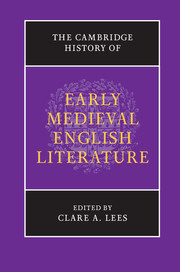Book contents
- Frontmatter
- Contents
- List of Illustrations
- List of Contributors
- Acknowledgements
- List of Abbreviations
- Introduction: literature in Britain and Ireland to 1150
- I WORD, SCRIPT AND IMAGE
- II EARLY ENGLISH LITERATURE
- III LATIN LEARNING AND THE LITERARY VERNACULARS
- 19 In measure, and number, and weight: writing science
- 20 Legal documentation and the practice of English law
- 21 Latinities, 893–1143
- 22 The authority of English, 900–1150
- 23 Crossing the language divide: Anglo-Scandinavian language and literature
- 24 European literature and eleventh-century England
- 25 Gaelic literature in Ireland and Scotland, 900–1150
- 26 Writing in Welsh to 1150: (re)creating the past, shaping the future
- Bibliography
- Index of manuscripts
- Index
24 - European literature and eleventh-century England
from III - LATIN LEARNING AND THE LITERARY VERNACULARS
Published online by Cambridge University Press: 05 February 2013
- Frontmatter
- Contents
- List of Illustrations
- List of Contributors
- Acknowledgements
- List of Abbreviations
- Introduction: literature in Britain and Ireland to 1150
- I WORD, SCRIPT AND IMAGE
- II EARLY ENGLISH LITERATURE
- III LATIN LEARNING AND THE LITERARY VERNACULARS
- 19 In measure, and number, and weight: writing science
- 20 Legal documentation and the practice of English law
- 21 Latinities, 893–1143
- 22 The authority of English, 900–1150
- 23 Crossing the language divide: Anglo-Scandinavian language and literature
- 24 European literature and eleventh-century England
- 25 Gaelic literature in Ireland and Scotland, 900–1150
- 26 Writing in Welsh to 1150: (re)creating the past, shaping the future
- Bibliography
- Index of manuscripts
- Index
Summary
Ælfric died in about 1010, Wulfstan in 1023. Byrhtferth of Ramsey had probably completed his last work by the time of the latter’s death, and by such a date all four of the major codices of Old English poetry had been compiled. In other words, the early decades of the eleventh century have a strong sense of endings about them, at least in terms of literary history, and handbooks of Anglo-Saxon literature rarely have much to say about the period that followed, from Wulfstan’s death to the Norman Conquest. In most accounts, the important events of Anglo-Saxon literary history were all over and done with some decades in advance of 1066.
This chapter will argue against this view by propounding three related theses: first, that far more was happening in eleventh- and early twelfth-century literary culture in England than traditional accounts might suggest; second, that continuities across the supposed gulf of 1066 mean that an informed understanding of late Anglo-Saxon and early Anglo-Norman literary culture can only be achieved by scrutinizing literary activity in England for some decades after that watershed date as well as before; and third, that the key quality that characterizes and animates this period’s literary culture is a pervasive, and productive, internationalism. Ultimately, the changing literature of the long eleventh century was made possible by important continuities in patronage and England’s lasting appeal to ambitious foreign clerics across the period.
- Type
- Chapter
- Information
- The Cambridge History of Early Medieval English Literature , pp. 607 - 636Publisher: Cambridge University PressPrint publication year: 2012
- 1
- Cited by

